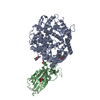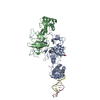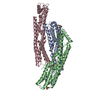[English] 日本語
 Yorodumi
Yorodumi- PDB-7c8j: Structural basis for cross-species recognition of COVID-19 virus ... -
+ Open data
Open data
- Basic information
Basic information
| Entry | Database: PDB / ID: 7c8j | ||||||
|---|---|---|---|---|---|---|---|
| Title | Structural basis for cross-species recognition of COVID-19 virus spike receptor binding domain to bat ACE2 | ||||||
 Components Components |
| ||||||
 Keywords Keywords |  VIRAL PROTEIN/PROTEIN BINDING / VIRAL PROTEIN/PROTEIN BINDING /  COVID-19 / receptor binding domain (RBD) / Rhinolophus macrotis / bats / COVID-19 / receptor binding domain (RBD) / Rhinolophus macrotis / bats /  ACE2 / ACE2 /  VIRAL PROTEIN-PROTEIN BINDING complex VIRAL PROTEIN-PROTEIN BINDING complex | ||||||
| Function / homology |  Function and homology information Function and homology information Hydrolases; Acting on peptide bonds (peptidases) / peptidyl-dipeptidase activity / Hydrolases; Acting on peptide bonds (peptidases) / peptidyl-dipeptidase activity /  carboxypeptidase activity / carboxypeptidase activity /  cilium / cilium /  metallopeptidase activity / Maturation of spike protein / viral translation / Translation of Structural Proteins / Virion Assembly and Release / host cell surface ... metallopeptidase activity / Maturation of spike protein / viral translation / Translation of Structural Proteins / Virion Assembly and Release / host cell surface ... Hydrolases; Acting on peptide bonds (peptidases) / peptidyl-dipeptidase activity / Hydrolases; Acting on peptide bonds (peptidases) / peptidyl-dipeptidase activity /  carboxypeptidase activity / carboxypeptidase activity /  cilium / cilium /  metallopeptidase activity / Maturation of spike protein / viral translation / Translation of Structural Proteins / Virion Assembly and Release / host cell surface / host extracellular space / suppression by virus of host tetherin activity / Induction of Cell-Cell Fusion / structural constituent of virion / host cell endoplasmic reticulum-Golgi intermediate compartment membrane / entry receptor-mediated virion attachment to host cell / receptor-mediated endocytosis of virus by host cell / Attachment and Entry / metallopeptidase activity / Maturation of spike protein / viral translation / Translation of Structural Proteins / Virion Assembly and Release / host cell surface / host extracellular space / suppression by virus of host tetherin activity / Induction of Cell-Cell Fusion / structural constituent of virion / host cell endoplasmic reticulum-Golgi intermediate compartment membrane / entry receptor-mediated virion attachment to host cell / receptor-mediated endocytosis of virus by host cell / Attachment and Entry /  membrane fusion / positive regulation of viral entry into host cell / receptor-mediated virion attachment to host cell / membrane fusion / positive regulation of viral entry into host cell / receptor-mediated virion attachment to host cell /  receptor ligand activity / host cell surface receptor binding / apical plasma membrane / fusion of virus membrane with host plasma membrane / fusion of virus membrane with host endosome membrane / receptor ligand activity / host cell surface receptor binding / apical plasma membrane / fusion of virus membrane with host plasma membrane / fusion of virus membrane with host endosome membrane /  viral envelope / virion attachment to host cell / SARS-CoV-2 activates/modulates innate and adaptive immune responses / host cell plasma membrane / virion membrane / viral envelope / virion attachment to host cell / SARS-CoV-2 activates/modulates innate and adaptive immune responses / host cell plasma membrane / virion membrane /  proteolysis / extracellular region / proteolysis / extracellular region /  membrane / identical protein binding / membrane / identical protein binding /  metal ion binding / metal ion binding /  plasma membrane / plasma membrane /  cytoplasm cytoplasmSimilarity search - Function | ||||||
| Biological species |   Rhinolophus macrotis (Big-eared Horseshoe Bat) Rhinolophus macrotis (Big-eared Horseshoe Bat)  Severe acute respiratory syndrome coronavirus 2 Severe acute respiratory syndrome coronavirus 2 | ||||||
| Method |  X-RAY DIFFRACTION / X-RAY DIFFRACTION /  SYNCHROTRON / SYNCHROTRON /  MOLECULAR REPLACEMENT / Resolution: 3.18 Å MOLECULAR REPLACEMENT / Resolution: 3.18 Å | ||||||
 Authors Authors | Liu, K.F. / Wang, J. / Tan, S.G. / Niu, S. / Wu, L.L. / Zhang, Y.F. / Pan, X.Q. / Meng, Y.M. / Chen, Q. / Wang, Q.H. ...Liu, K.F. / Wang, J. / Tan, S.G. / Niu, S. / Wu, L.L. / Zhang, Y.F. / Pan, X.Q. / Meng, Y.M. / Chen, Q. / Wang, Q.H. / Wang, H.W. / Qi, J.X. / Gao, G.F. | ||||||
 Citation Citation |  Journal: Proc Natl Acad Sci U S A / Year: 2021 Journal: Proc Natl Acad Sci U S A / Year: 2021Title: Cross-species recognition of SARS-CoV-2 to bat ACE2. Authors: Kefang Liu / Shuguang Tan / Sheng Niu / Jia Wang / Lili Wu / Huan Sun / Yanfang Zhang / Xiaoqian Pan / Xiao Qu / Pei Du / Yumin Meng / Yunfei Jia / Qian Chen / Chuxia Deng / Jinghua Yan / ...Authors: Kefang Liu / Shuguang Tan / Sheng Niu / Jia Wang / Lili Wu / Huan Sun / Yanfang Zhang / Xiaoqian Pan / Xiao Qu / Pei Du / Yumin Meng / Yunfei Jia / Qian Chen / Chuxia Deng / Jinghua Yan / Hong-Wei Wang / Qihui Wang / Jianxun Qi / George Fu Gao /  Abstract: The coronavirus disease 2019 (COVID-19) pandemic caused by severe acute respiratory syndrome coronavirus 2 (SARS-CoV-2) has emerged as a major threat to global health. Although varied SARS-CoV-2- ...The coronavirus disease 2019 (COVID-19) pandemic caused by severe acute respiratory syndrome coronavirus 2 (SARS-CoV-2) has emerged as a major threat to global health. Although varied SARS-CoV-2-related coronaviruses have been isolated from bats and SARS-CoV-2 may infect bat, the structural basis for SARS-CoV-2 to utilize the human receptor counterpart bat angiotensin-converting enzyme 2 (bACE2) for virus infection remains less understood. Here, we report that the SARS-CoV-2 spike protein receptor binding domain (RBD) could bind to bACE2 from (bACE2-Rm) with substantially lower affinity compared with that to the human ACE2 (hACE2), and its infectivity to host cells expressing bACE2-Rm was confirmed with pseudotyped SARS-CoV-2 virus and SARS-CoV-2 wild virus. The structure of the SARS-CoV-2 RBD with the bACE2-Rm complex was determined, revealing a binding mode similar to that of hACE2. The analysis of binding details between SARS-CoV-2 RBD and bACE2-Rm revealed that the interacting network involving Y41 and E42 of bACE2-Rm showed substantial differences with that to hACE2. Bats have extensive species diversity and the residues for RBD binding in bACE2 receptor varied substantially among different bat species. Notably, the Y41H mutant, which exists in many bats, attenuates the binding capacity of bACE2-Rm, indicating the central roles of Y41 in the interaction network. These findings would benefit our understanding of the potential infection of SARS-CoV-2 in varied species of bats. | ||||||
| History |
|
- Structure visualization
Structure visualization
| Structure viewer | Molecule:  Molmil Molmil Jmol/JSmol Jmol/JSmol |
|---|
- Downloads & links
Downloads & links
- Download
Download
| PDBx/mmCIF format |  7c8j.cif.gz 7c8j.cif.gz | 418.3 KB | Display |  PDBx/mmCIF format PDBx/mmCIF format |
|---|---|---|---|---|
| PDB format |  pdb7c8j.ent.gz pdb7c8j.ent.gz | 304.1 KB | Display |  PDB format PDB format |
| PDBx/mmJSON format |  7c8j.json.gz 7c8j.json.gz | Tree view |  PDBx/mmJSON format PDBx/mmJSON format | |
| Others |  Other downloads Other downloads |
-Validation report
| Arichive directory |  https://data.pdbj.org/pub/pdb/validation_reports/c8/7c8j https://data.pdbj.org/pub/pdb/validation_reports/c8/7c8j ftp://data.pdbj.org/pub/pdb/validation_reports/c8/7c8j ftp://data.pdbj.org/pub/pdb/validation_reports/c8/7c8j | HTTPS FTP |
|---|
-Related structure data
| Related structure data |  7c8kC  6lzgS S: Starting model for refinement C: citing same article ( |
|---|---|
| Similar structure data |
- Links
Links
- Assembly
Assembly
| Deposited unit | 
| ||||||||||||
|---|---|---|---|---|---|---|---|---|---|---|---|---|---|
| 1 |
| ||||||||||||
| Unit cell |
|
- Components
Components
| #1: Protein |  Mass: 82350.930 Da / Num. of mol.: 1 Source method: isolated from a genetically manipulated source Source: (gene. exp.)   Rhinolophus macrotis (Big-eared Horseshoe Bat) Rhinolophus macrotis (Big-eared Horseshoe Bat)Gene: ACE2 / Production host:   Escherichia coli (E. coli) Escherichia coli (E. coli)References: UniProt: E2DHI3,  Hydrolases; Acting on peptide bonds (peptidases) Hydrolases; Acting on peptide bonds (peptidases) |
|---|---|
| #2: Protein | Mass: 21873.496 Da / Num. of mol.: 1 / Fragment: UNP residues 333-527 Source method: isolated from a genetically manipulated source Source: (gene. exp.)   Severe acute respiratory syndrome coronavirus 2 Severe acute respiratory syndrome coronavirus 2Gene: S, 2 Production host: Insect cell expression vector pTIE1 (others) References: UniProt: P0DTC2 |
| #3: Chemical | ChemComp-ZN / |
| Has ligand of interest | Y |
-Experimental details
-Experiment
| Experiment | Method:  X-RAY DIFFRACTION / Number of used crystals: 1 X-RAY DIFFRACTION / Number of used crystals: 1 |
|---|
- Sample preparation
Sample preparation
| Crystal | Density Matthews: 3.38 Å3/Da / Density % sol: 63.62 % |
|---|---|
Crystal grow | Temperature: 291 K / Method: vapor diffusion, sitting drop Details: 0.1 M Succinic acid pH 7.0, 0.1 M BICINE pH 8.5, 30% v/v Polyethylene glycol monomethyl ether 550 |
-Data collection
| Diffraction | Mean temperature: 100 K / Serial crystal experiment: N |
|---|---|
| Diffraction source | Source:  SYNCHROTRON / Site: SYNCHROTRON / Site:  SSRF SSRF  / Beamline: BL19U1 / Wavelength: 0.97853 Å / Beamline: BL19U1 / Wavelength: 0.97853 Å |
| Detector | Type: SDMS / Detector: CMOS / Date: May 10, 2020 |
| Radiation | Protocol: SINGLE WAVELENGTH / Monochromatic (M) / Laue (L): M / Scattering type: x-ray |
| Radiation wavelength | Wavelength : 0.97853 Å / Relative weight: 1 : 0.97853 Å / Relative weight: 1 |
| Reflection | Resolution: 3.18→48.1 Å / Num. obs: 22038 / % possible obs: 99.9 % / Redundancy: 13.4 % / Biso Wilson estimate: 65.43 Å2 / Rmerge(I) obs: 0.163 / Net I/σ(I): 15.6 |
| Reflection shell | Resolution: 3.18→48.1 Å / Rmerge(I) obs: 1.79 |
- Processing
Processing
| Software |
| |||||||||||||||||||||||||||||||||||||||||||||||||||||||||||||||||||||||||||
|---|---|---|---|---|---|---|---|---|---|---|---|---|---|---|---|---|---|---|---|---|---|---|---|---|---|---|---|---|---|---|---|---|---|---|---|---|---|---|---|---|---|---|---|---|---|---|---|---|---|---|---|---|---|---|---|---|---|---|---|---|---|---|---|---|---|---|---|---|---|---|---|---|---|---|---|---|
| Refinement | Method to determine structure : :  MOLECULAR REPLACEMENT MOLECULAR REPLACEMENTStarting model: 6LZG Resolution: 3.18→48.1 Å / SU ML: 0.3609 / Cross valid method: FREE R-VALUE / σ(F): 1.35 / Phase error: 27.2328 Stereochemistry target values: GeoStd + Monomer Library + CDL v1.2
| |||||||||||||||||||||||||||||||||||||||||||||||||||||||||||||||||||||||||||
| Solvent computation | Shrinkage radii: 0.9 Å / VDW probe radii: 1.11 Å / Solvent model: FLAT BULK SOLVENT MODEL | |||||||||||||||||||||||||||||||||||||||||||||||||||||||||||||||||||||||||||
| Displacement parameters | Biso mean: 62.21 Å2 | |||||||||||||||||||||||||||||||||||||||||||||||||||||||||||||||||||||||||||
| Refinement step | Cycle: LAST / Resolution: 3.18→48.1 Å
| |||||||||||||||||||||||||||||||||||||||||||||||||||||||||||||||||||||||||||
| Refine LS restraints |
| |||||||||||||||||||||||||||||||||||||||||||||||||||||||||||||||||||||||||||
| LS refinement shell |
| |||||||||||||||||||||||||||||||||||||||||||||||||||||||||||||||||||||||||||
| Refinement TLS params. | Method: refined / Refine-ID: X-RAY DIFFRACTION
| |||||||||||||||||||||||||||||||||||||||||||||||||||||||||||||||||||||||||||
| Refinement TLS group |
|
 Movie
Movie Controller
Controller











 PDBj
PDBj





